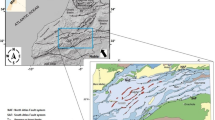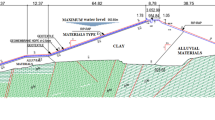Abstract
Because of the viscoelastic behaviour of the earth, accumulation of elastic strain energy by tectonic loading and release of such energy by earthquake fault slips at subduction zones may take place on different spatial scales. If the lithospheric plate is acted upon by distant tectonic forces, strain accumulation must occur in a broad region. However, an earthquake releases strain only in a region comparable to the size of the rupture area. A two-dimensional finite-element model of a subduction zone with viscoelastic rheology has been used to investigate the coupling of tectonic loading and earthquake fault slips. A fault lock-and-unlock technique is employed so that the amount of fault slip in an earthquake is not prescribed, but determined by the accumulated stress. The amount of earthquake fault slip as a fraction of the total relative plate motion depends on the relative sizes of the earthquake rupture area and the region of tectonic strain accumulation, as well as the rheology of the rock material. The larger the region of strain accumulation is compared to the earthquake rupture, the smaller is the earthquake fault slip. The reason for the limited earthquake fault slip is that the elastic shear stress in the asthenosphere induced by the earthquake resists the elastic rebound of the overlying plate. Since rapid permanent plate shortening is not observed at subduction zones, there must be either strain release over a large region or strain accumulation over a small region over earthquake cycles. The former can be achieved only by significant aseismic fault slip between large subduction earthquakes. The most likely mechanism for the latter is the accumulation of elastic strain around isolated locked asperities of the fault, which requires significant aseismic fault slip between asperities.
Similar content being viewed by others
References
Andrews, D. J. (1978),Coupling of Energy Between Tectonic Processes and Earthquakes. J. Geophys. Res.83, 2259–2264.
Barriendos, S. E., andWard, S. N. (1990),The 1960 Chile Earthquake: Inversion for Slip Distribution from Surface Deformation, Geophys. J. Int.103, 589–598.
Bott, M. H. P., andDean, D. S. (1973),Stress Diffusion from Plate Boundaries, Nature,243, 339–341.
Carlson, R. L. (1983),Plate Motions, Boundary Forces, and Horizontal Temperature Gradients: Implications for the Driving Mechanism, Tectonophys.99, 149–164.
Carslaw, H. S., andJaeger, J. C.,Conduction of Heat in Solids (Oxford University Press, Oxford 1959).
Cohen, S. C. (1992),Postseismic Deformation and Stress Diffusion Due to Viscoelasticity and Comments on the Modified Elsasser Model, J. Geophys. Res.97, 15,395–15,403.
Davies, G. F., andBrune, J. N. (1971),Regional and Global Fault Slip Rates from Seismicity, Nature Phys. Sci.229, 101–107.
Dragoni, M. (1990),A Model of Interseismic Fault Slip in the Presence of Asperities, Geophys. J. Int.101, 147–156.
Elsasser, W. M.,Convection and Stress Propagation in the Upper Mantle. InThe Application of Modern Physics to the Earth and Planetary Interiors (ed. Runconr, S. K.) (John Wiley, New York 1969) pp. 223–246.
England, P., andJackson, J. (1989),Active Deformation of the Continents, Ann. Rev. Earth Planet. Sci.17, 197–226.
Hickman, S. H., Stress in the lithosphere and the strength of active faults, U.S. National Report to the International Union of Geodesy and Geophysics 1987–1990,Rev. Geophys. Suppl., pp. 759–775, April, 1991.
Kanamori, H., andCipar, J. J. (1974),Focal Process of the Great Chilean Earthquake May 22, 1960, Phys. Earth Planet. Int.9, 128–136.
Kanamori, H., andKikuchi, M. (1993),The 1992 Nicaragua Earthquake: A Slow Tsunami Earthquake Associated with Subducted Sediments, Nature361, 714–716.
Karato, S., andWu, P. (1993),Rheology of the Upper Mantle: A Synthesis, Science260, 771–778.
Lachenbruch, A., andSass, J. H. (1980),Heat Flow and Energetics of the San Andreas Fault Zone, J. Geophys. Res.85, 6185–6222.
Lang, G., Vilotte, J. P., andNeugebauer, H. J. (1989),Relexation of the Earth after a Dip Slip Earthquake: Dependence on Rheology and Geometry, Phys. Earth Planet. Int.56, 349–370.
Lay, T., andKanamori, H.,An asperity model of large earthquake sequence. InEarthquake Prediction—An International Review, Maurice Ewing Ser. (eds. Simpson, D. W., and Richards, P. G.) (American Geophysical Union, Washington, D. C. 1982) pp. 579–592.
Massonnet, D., Rossi, M., Carmona, C., Adragna, F., Peltzer, G., Feigi, K. andRabaute, T. (1993),The Displacement Field of the Landers Earthquake Mapped by Radar Interferometry, Nature364, 138–142.
Melosh, H. J.,Rheology of the earth: Theory and observation. InPhysics of the Earth's Interior, Proceedings of the 1979 Enrico Fermi Summer School, Varena, Italy (Dziewonski, A. M., and Boschi, E., eds.) (North Holland, Amsterdam 1980) pp. 318–336.
Melosh, H. J., andRaefsky, A. (1983),Inelastic Response of the Earth to a Dip Slip Earthquake, J. Geophys. Res.88, 515–526.
Melosh, H. J., andWilliams, C. A., Jr. (1989),Mechanics of Graben Formation in Crustal Rocks: A Finite Element Analysis, J. Geophys. Res.94, 13,961–13,973.
Miyashita, K. (1987),A Model of Plate Convergence in Southwest Japan, Inferred from Levelling Data Associated With the 1946 Nankaido Earthquake, J. Phys. Earth35, 449–467.
Orowan, E. (1960),Mechanism of Seismic Faulting in Rock Deformation: A Symposium, Geol. Soc. Am. Mem.729, 323–345.
Pacheco, J. F., Sykes, L. R., andScholz, C. H. (1993),Nature of Seismic Coupling Along Simple Plate Boundaries of the Subduction Type, J. Geophys. Res.98, 14,133–14,159.
Peltier, W. R. (1974),The Impulse Response of a Maxwell Earth, Rev. Geophys.12, 649–669.
Plafker, G., andSavage, J. C. (1970),Mechanism of the Chilean Earthquake of May 21 and 22, 1960, Geol. Soc. Am. Bull.81, 1001–1030.
Purcell, G. H., Jr.,Young, L. E., Spiess, F. N., Boegeman, D. E., Lawhead, R. M., Dragert, H., Schmidt M., Jewsbury, G., Lisowski, M., andDeMets, D. C. (1993),Status of GPS/Acoustic Measurements of Seafloor Strain Accumulation Across the Cascadia Subduction Zone (Abstract), EOS, AGU Transact.74, 200.
Rydelek, P. A., andSacks, I. S. (1990),Asthenospheric Viscosity and Stress Diffusion in NE Japan, Geophys. J. Int.100, 39–58.
Sacks, I. S., andLinde, A. T.,Slow Earthquakes and Stress Redistribution in the Earth (Abstract), in IUGG XX General Assembly Abstracts V. 1 (1987), 37 pp.
Satake, K. (1993),Depth Distribution of Coseismic Slip Along the Nankai Trough, Japan, From Joint Inversion of Geodetic and Tsunami Data, J. Geophys. Res.98, 4553–4565.
Savage, J. C. (1983),A Dislocation Model of Strain Accumulation and Release at a Subduction Zone, J. Geophys. Res.88, 4984–4996.
Savage, J. C., andWood, M. D. (1971),The Relation Between Apparent Stress and Stress Drop, Bull. Seismol. Soc. Am.61, 1381–1388.
Sleep, N. H., andToksöz, M. N. (1971),Evolution of Marginal Basins, Nature233, 548–550.
Stuart, W. D. (1988),Forecast Model for Great Earthquakes at the Nankai Trough Subduction Zone, Pure and Appl. Geophys.126, 619–641.
Thatcher, W. (1984),The Earthquake Deformation Cycle at the Nankai Trough, Southwest Japan, J. Geophys. Res.89, 3087–3101.
Thatcher, W., andRundle, J. B. (1984),A Viscoelastic Coupling Model for the Cyclic Deformation due to Periodically Repeated Earthquakes at Subduction Zones, J. Geophys. Res.89, 7631–7640.
Tse, S. T., andRice, J. R. (1986),Crustal Earthquake Instability in Relation to the Depth Variation of Frictional Slip Properties, J. Geophys. Res.91, 9452–9472.
Tushingham, A. M., andPeltier, W. R. (1992),Validation of the ICE-3G Model of Wurm-Wisconsin Deglaciation Using a Global Data Base of Relative Sea Level Histories, J. Geophys. Res.97, 3285–3304.
Wahr, J., andWyss, M. (1980),Interpretation of Postseismic Deformation with a Viscoelastic Relaxation Model, J. Geophys. Res.85, 6471–6477.
Wang, K., Dragert, H., andMelosh, H. J. (1994),Finite Element Study of Uplift and Strain Across Vancouver Island, Can. J. Earth. Sci.31, 1510–1522.
Wang, K., Mulder, T., Rogers, G. C., andHyndman, R. D. (1995),Case for Very Low Coupling Stress on the Cascadia Subduction Fault, J. Geophys. Res., in press.
Wu, P. (1992),Deformation of an Incompressible Viscoelastic Flat Earth with Power-law Creep. Geophys. J. Int.108, 35–51.
Yabuki, T., andMatsu'ura, M. (1992),Geodetic Data Inversion Using a Bayesian Information Criterion for Spatial Distribution of Fault Slip, Geophys. J. Int.109, 363–375.
Zoback, M. L. (1992),First- and Second-order Patterns of Stress in the Lithosphere: The World Stress Map Project, J. Geophys. Res.97, 11,703–11,728.
Zuniga, F. R. (1993),Frictional Overshoot and Partial Stress Drop. Which One?. Bull. Seismol. Soc. Am.83, 939–944.
Author information
Authors and Affiliations
Rights and permissions
About this article
Cite this article
Wang, K. Coupling of tectonic loading and earthquake fault slips at subduction zones. PAGEOPH 145, 537–559 (1995). https://doi.org/10.1007/BF00879588
Received:
Revised:
Accepted:
Issue Date:
DOI: https://doi.org/10.1007/BF00879588




